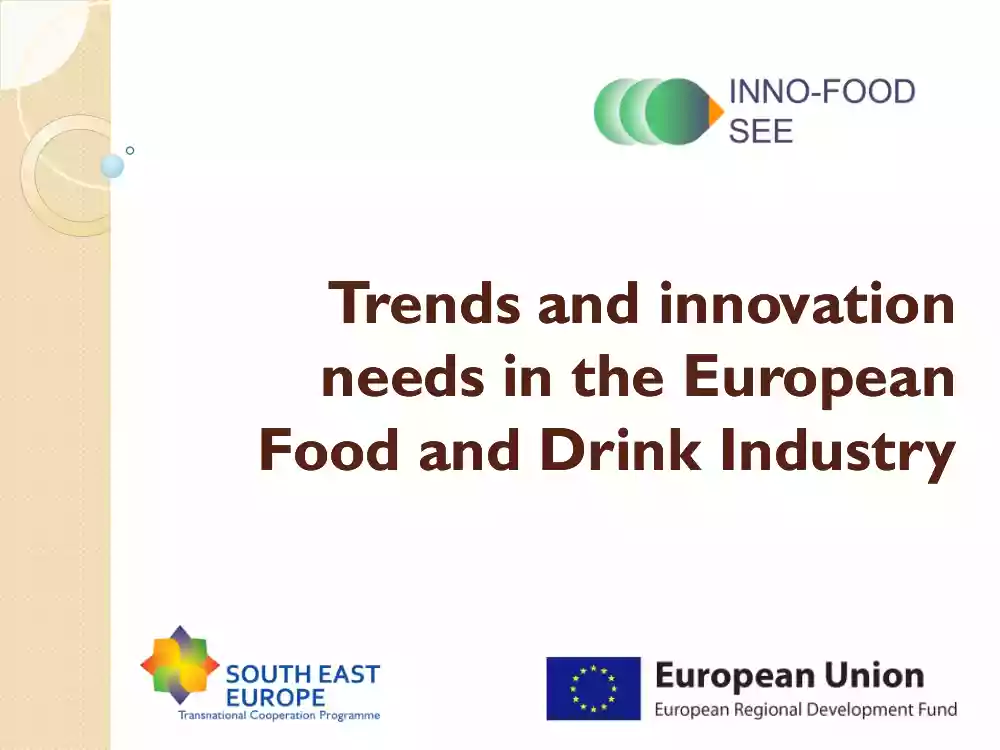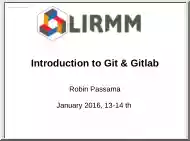Please log in to read this in our online viewer!

Please log in to read this in our online viewer!
No comments yet. You can be the first!
Content extract
Trends and innovation needs in the European Food and Drink Industry European Food and Drink Industry-- Key Data Industry European Food and Drink Industry- Key Data European Food and Drink Industry-- Key Data Industry Food and drink industry is less innovative compared to other manufacturing sectors but EU food and drink companies innovate more than anywhere else in the world Innovation objectives of the food industry European Food Industry: Key Challenges Increased international competition Increased worldwide food demand Concerns for food safety and quality Interest in added- value food Changing attitudes and emerging consumer trends Consumer Trends in Food selection The XTC Trends Tree™ is a hierarchical structure that summarizes overall consumer expectations and categorizes them under five axes, and then breaks them down into innovation trends and subsequently into the new drivers used by the world’s manufacturers to meet these
expectations, http://www.xtcworldinnovationcom European Technology Platform Food for Life Challenges 1. Ensuring that the healthy choice is the easy choice for consumers 2. Delivering a healthy diet 3. Developing value-added food products with superior quality, convenience, availability and affordability 4. Assuring safe foods that consumers can trust, 5. Achieving sustainable food production 6. Managing the food chain 7. Communication, training and technology transfer, competitiveness and consumer interaction Challenge 1: Ensuring that the healthy choice is the easy choice for consumers Challenge 2: Delivering a healthier diet Goal 1: Better and agreed upon Goal 1: Understanding brain measurement in food consumer Science Goal 2: Developing comprehensive models of consumer food choice processes Goal 3: Promoting effective interaction with consumer groups and consumers directly through communication and public participation Goal 4. Developing strategies to
induce behavioural change in order to improve consumer health and social responsibility (through healthier food choices) function in relation to diet Goal 2: Understanding effects of diet-gut interactions on intestinal and immune functions Goal 3: Understanding the link between diet and metabolic function (obesity and associated metabolic disorders) Goal 4: Understanding consumer behaviour and effective communication in relation to health and nutrition Challenge 3: Developing quality food products Challenge 4: Assuring safe foods that consumers can trust Goal 1: Relevance of the research Goal 1. Predicting and monitoring to small, medium or large enterprises the behaviour and fate of relevant known and emerging biological hazards Goal 2: Define the needs to develop specific training and/or education programs Goal 2. Predicting and monitoring areas of research defined as high priority the behaviour and fate of relevant known and emerging chemical
hazards including toxins of biological origin Goal 4: Investments in Goal 3. Improving risk assessment Goal 3: The need for ERA-Nets in infrastructure and risk-benefit evaluation Goal 4. Developing tools to ensure security of the food chain Goal 5. Understanding and addressing consumer concerns with food safety issues Challenge 5: Achieving sustainable food production Challenge 6: Managing the food chain Goal 1. Progressing the Goal 1: Serving consumer needs sustainability of food production and supply in Europe for affordable food of quality and diversity Goal 2. Developing scenarios of Goal 2: Serving transparency needs future European food production and supply for advancements in chain governance, efficiency, innovation dynamics, and trust Goal 3: Developing sustainable processing, preservation, packaging and logistics systems Goal 3: Serving SME needs for Goal 4. Ensuring sustainable better integration into value chain
relationships primary food production in Europe Goal 4: Serving sector needs for Goal 5. Understanding consumers better understanding the dynamics in critical success factors for competitive performance and sustainability in times of globalisation and change and their behaviour regarding sustainable food production The integrated picture- social, consumer and science needs (Source: European Technology Platform “Food for Life”, Strategic Research Agenda 2007-2020, http://etp.ciaabe/documents/CIAA-ETP%20broch LRpdf) Thank you!
expectations, http://www.xtcworldinnovationcom European Technology Platform Food for Life Challenges 1. Ensuring that the healthy choice is the easy choice for consumers 2. Delivering a healthy diet 3. Developing value-added food products with superior quality, convenience, availability and affordability 4. Assuring safe foods that consumers can trust, 5. Achieving sustainable food production 6. Managing the food chain 7. Communication, training and technology transfer, competitiveness and consumer interaction Challenge 1: Ensuring that the healthy choice is the easy choice for consumers Challenge 2: Delivering a healthier diet Goal 1: Better and agreed upon Goal 1: Understanding brain measurement in food consumer Science Goal 2: Developing comprehensive models of consumer food choice processes Goal 3: Promoting effective interaction with consumer groups and consumers directly through communication and public participation Goal 4. Developing strategies to
induce behavioural change in order to improve consumer health and social responsibility (through healthier food choices) function in relation to diet Goal 2: Understanding effects of diet-gut interactions on intestinal and immune functions Goal 3: Understanding the link between diet and metabolic function (obesity and associated metabolic disorders) Goal 4: Understanding consumer behaviour and effective communication in relation to health and nutrition Challenge 3: Developing quality food products Challenge 4: Assuring safe foods that consumers can trust Goal 1: Relevance of the research Goal 1. Predicting and monitoring to small, medium or large enterprises the behaviour and fate of relevant known and emerging biological hazards Goal 2: Define the needs to develop specific training and/or education programs Goal 2. Predicting and monitoring areas of research defined as high priority the behaviour and fate of relevant known and emerging chemical
hazards including toxins of biological origin Goal 4: Investments in Goal 3. Improving risk assessment Goal 3: The need for ERA-Nets in infrastructure and risk-benefit evaluation Goal 4. Developing tools to ensure security of the food chain Goal 5. Understanding and addressing consumer concerns with food safety issues Challenge 5: Achieving sustainable food production Challenge 6: Managing the food chain Goal 1. Progressing the Goal 1: Serving consumer needs sustainability of food production and supply in Europe for affordable food of quality and diversity Goal 2. Developing scenarios of Goal 2: Serving transparency needs future European food production and supply for advancements in chain governance, efficiency, innovation dynamics, and trust Goal 3: Developing sustainable processing, preservation, packaging and logistics systems Goal 3: Serving SME needs for Goal 4. Ensuring sustainable better integration into value chain
relationships primary food production in Europe Goal 4: Serving sector needs for Goal 5. Understanding consumers better understanding the dynamics in critical success factors for competitive performance and sustainability in times of globalisation and change and their behaviour regarding sustainable food production The integrated picture- social, consumer and science needs (Source: European Technology Platform “Food for Life”, Strategic Research Agenda 2007-2020, http://etp.ciaabe/documents/CIAA-ETP%20broch LRpdf) Thank you!




 When reading, most of us just let a story wash over us, getting lost in the world of the book rather than paying attention to the individual elements of the plot or writing. However, in English class, our teachers ask us to look at the mechanics of the writing.
When reading, most of us just let a story wash over us, getting lost in the world of the book rather than paying attention to the individual elements of the plot or writing. However, in English class, our teachers ask us to look at the mechanics of the writing.